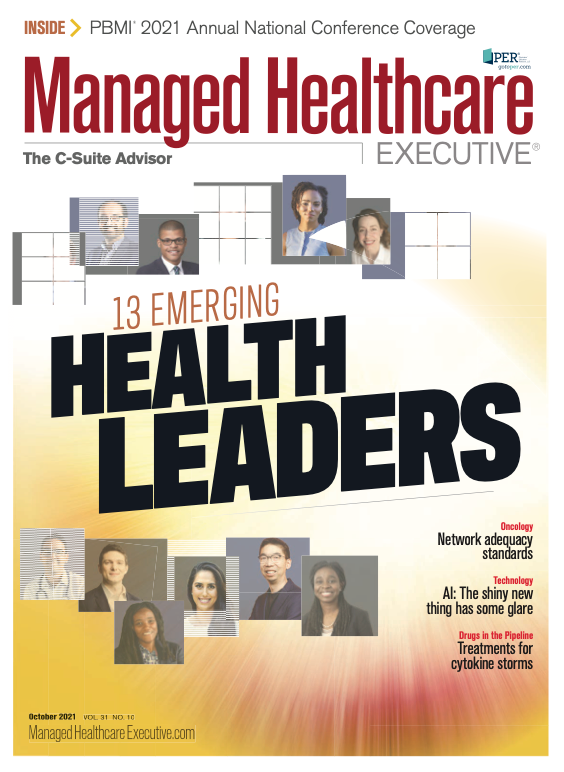Emerging Health Leaders: Sonia Samagh of Stealth Venture
Samagh is one of 13 up-and-coming health leaders featured in this annual Managed Healthcare Executive series.
Editor’s note: Samagh left her position at Optum Health in September.
Sonia Samagh, M.D., M.B.A., partner, Stealth Venture Fund, former vice president, The Center for Digital Health and Innovation, Optum Health

I was raised in San Diego. I earned an MBA from Stanford University and an M.D. from UCSF School of Medicine, and I currently practice as a hospital medicine physician.
I’m a founding member and vice president of The Center for Digital Health (CDH) and Innovation at Optum Health. For the past 10 years, I have worked at healthcare organizations, leading medical groups through value-based care transformation and serving in corporate strategy, operations and venture roles. I have led and implemented digital health strategy and innovation efforts across Optum, including digital health product development, corporate partnerships and clinical redesign for virtual care delivery.
Who has had the greatest influence on your life?
My parents. Watching them overcome incredible odds to both migrate to this country and overcome health issues has been a huge inspiration in lessons on perseverance, grit and tenacity. The value system they instilled in me makes me want to live an authentic and fulfilled life with service to others, human-centered compassion and a hope to change the world.
Why did you pursue a career in healthcare?
As an internal medicine physician, I see the effects of the healthcare system on patients and providers. I also see the amazing advancements made in technology and innovation. There is such potential for the ways that we can care for one another and create a health system where feeling better is a result of many ways that we interact with our bodies, minds and each other.
I believe physicians need a seat at the table to design our system of health and ensure that the system we create treats the whole person. I also believe that there is a chasm between what I am able to accomplish as a physician with my patients and what is possible with technology and innovation. My goal in healthcare is to close that gap.
Which career accomplishment has given you the greatest satisfaction?
When COVID-19 resulted in a rapid need to transition our 10,000 providers onto scalable, national telemedicine and remote patient monitoring systems, I founded and led Optum’s Digital Response Team (DRT). The DRT served as the foundation for our Optum Center for Digital Health and Innovation and consisted of 115 teammates rapidly deploying telehealth solutions and remote patient monitoring nationwide. We came together across our enterprise to support the infrastructure for rapid, coordinated, digital health scale, including launching a digital health support call center, local implementation teams and a digital nurse monitoring center. As a result, the DRT added more than 15,000 providers onto video visit platforms in eight weeks, completing more than 1.3 million virtual visits in 2020.
What has your organization’s role been in the rollout of COVID-19 vaccines?
Here are a just few examples of what Optum, along with its parent company UnitedHealth Group, has done to support the rollout of COVID-19 vaccines. We have worked with public health officials in California, Texas, North Carolina and Florida to set up community-based vaccination clinics. Through our care practices, community-based pharmacies and health services operations, Optum administered COVID-19 vaccines to patients, employees and other community members. And we created a COVID-19 vaccine resource locator to help people find vaccine eligibility and vaccination providers.
What would be the best way to reduce healthcare inequities in the U.S.?
To advance health equity, Optum Health is focused on delivering personalized care based on an individual’s needs, promoting equity and diversity in the health workforce, improving the health of underserved communities, and leveraging data and emerging analytics to monitor and address disparities in care.
Name a book or article that everyone in healthcare should read.
“Change by Design” by Tim Brown provides an introduction to the concept of design thinking and how it can transform organizations and inspire innovation. Design thinking’s tools and clear process steps help teams break free of human tendencies that can get in the way of innovation. I studied the elements of design thinking at Stanford Graduate School of Business and believe embracing the ethos of design thinking can truly help transform healthcare.

Conversations With Perry and Friends
April 14th 2025Perry Cohen, Pharm.D., a longtime member of the Managed Healthcare Executive editorial advisory board, is host of the Conversations with Perry and Friends podcast. His guest this episode is John Baackes, the former CEO of L.A. Care Health Plan.
Listen
Why Better Data and Awareness Matters for Medicaid Work Requirements
April 17th 2025With policymakers considering work requirements for Medicaid eligibility, Jennifer Haley, principal research associate in the Health Policy Division at the Urban Institute, said it’s more important than ever to understand how those changes could unintentionally cause harm, particularly when data systems fall short and public awareness is limited.
Read More
Breaking Down Health Plans, HSAs, AI With Paul Fronstin of EBRI
November 19th 2024Featured in this latest episode of Tuning In to the C-Suite podcast is Paul Fronstin, director of health benefits research at EBRI, who shed light on the evolving landscape of health benefits with editors of Managed Healthcare Executive.
Listen
Medicaid Expansion Linked To Timelier Lung Cancer Surgery and Access to High-Volume Hospitals
April 17th 2025New research shows that Medicaid expansion was linked to a 2.1% increase in timely lung cancer surgeries and a 2.8% rise in procedures at high-volume hospitals, highlighting how policy changes can impact cancer care access.
Read More